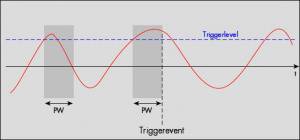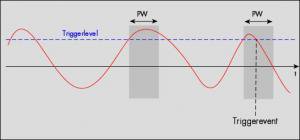-
Comparisons
-
Hardware Features
-
Systems
-
Software
-
Company
Knowledge-Base
- Hardware Features
- Trigger
Pulse Width Trigger
![]()
The trigger detection is extended by an additional pulse width counter that is measuring the size of a pulse. All the trigger modes running with pulse width counters are able to detect a trigger event that is shorter than the programmed pulse width or that is longer than the programmed pulse width. The trigger pulse width can be used for external trigger detection on a dedicated external trigger input and for channel trigger detection being combined with a number of available trigger modes like positive edge, negative edge or window trigger.
Trigger detection for pulses that are longer than a defined pulse width (break detection)
 The analog input is continuously sampled with the selected sample rate. If the programmed trigger level is crossed by the channel?s signal from lower to higher values (rising
The analog input is continuously sampled with the selected sample rate. If the programmed trigger level is crossed by the channel?s signal from lower to higher values (rising
edge) or from higher to lower values (falling edge) the pulse width counter is started. If the signal crosses the trigger level again in the opposite direction within the the programmed pulse width time, no trigger will be detected.
If the pulse width counter reaches the programmed amount of samples, without the signal crossing the trigger level in the opposite direction, the trigger event will be detected.
Trigger detection for pulses that are shorter than a defined pulse (glitch detection)
 The analog input is continuously sampled with the selected sample rate. If the programmed trigger level is crossed by the channel?s signal from lower to higher values (rising edge) or from higher to lower values (falling edge) the pulse width counter is started. If the pulse width counter reaches the programmed amount of samples, no trigger will be detected.
The analog input is continuously sampled with the selected sample rate. If the programmed trigger level is crossed by the channel?s signal from lower to higher values (rising edge) or from higher to lower values (falling edge) the pulse width counter is started. If the pulse width counter reaches the programmed amount of samples, no trigger will be detected.
If the signal does cross the trigger level again within the the programmed pulse width time, a trigger event will be detected.
Example: Detection a break
 Detection short breaks in signal connections (like cable test equipment) that exceed a certain time. The pulse width is programmed to the maximum length of the break that is acceptable and the trigger level is programmed to a level just beneath the test voltage level. On every break the size of the break is measured an compared with the programmed maximum allowed pulse width. If the break exceeds that limit a trigger is detected and the acquisition of that fault is done.
Detection short breaks in signal connections (like cable test equipment) that exceed a certain time. The pulse width is programmed to the maximum length of the break that is acceptable and the trigger level is programmed to a level just beneath the test voltage level. On every break the size of the break is measured an compared with the programmed maximum allowed pulse width. If the break exceeds that limit a trigger is detected and the acquisition of that fault is done.